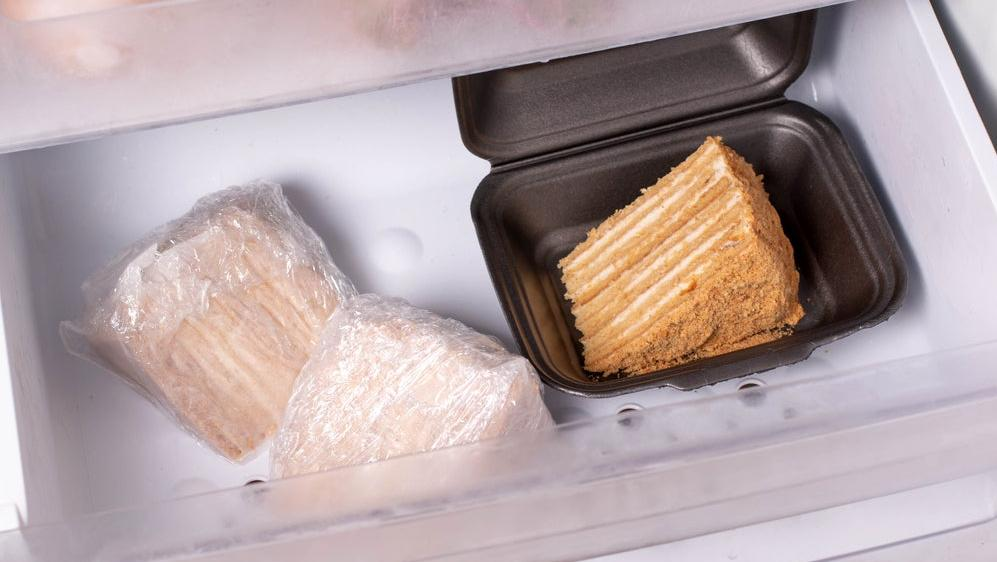How To Freeze Cake Without Ruining It
There's a right way and a wrong way to preserve your precious slices.
Yesterday, I made an impassioned argument for baking elaborate cakes as a solo apartment dweller. This came on the tail of a delightful weekend coconut cake project—a project that left me with two leftover slices, even after I gave away most of the cake to neighbors and coworkers. I definitely want to keep the leftover slices for myself, but the cake's already two days old. I realistically won't be able to finish the slices before they go stale—so how do I keep them fresh in the freezer?
To find out, I reached out to two skilled home bakers: Claire Porter, the most precise home baker I've ever met, and Hannah Binkley, who cut her teeth whipping up masterful baked goods at my favorite hometown coffee shop.
Step One: Flash freeze your cake
Binkley recommends starting with a flash freeze, which will firm up the icing so the cake stays nice and tidy. Place the cake uncovered in the freezer for about 20 minutes—until it's firm to the touch—before removing it and wrapping it up tight. If your cake is heavily iced, you may want to opt for a longer flash freeze. (Fun fact: Your cake's icing actually helps protect the cake from drying out in the freezer. Another excuse to lay on the buttercream, baby.)
Note: I'll probably skip the flash freeze step since I'm freezing individual slices, but this is a great tip for larger cake sections or full cakes.
Step Two: Wrap the cake
Now for the most important step, which Binkley calls the "plastic wrap mummification process." She advises that bakers "wrap the hell out of [the cake] with plastic wrap," noting that commercial plastic wrap is way easier to handle. Even if you're not working with commercial wrap, just set the cake on top of the plastic wrap and "lift the plastic wrap up and over so its butt is included in the plastic wrap mummification process." Don't neglect the butt! Do not! Neglect! The butt!
Generally, two layers of plastic wrap is enough to protect your cake from freezer burn—but if you're paranoid about the state of your cake, feel free to top the plastic wrap with an additional layer of aluminum foil. You can place your cake in a cake box to protect it from getting smushed by bags of frozen green beans.
Step Three: Deep freeze
Once you've wrapped the cake to your satisfaction, it's safe to pop it into the freezer. How long you freeze the cake is entirely up to you, although most experts recommend throwing it out after the one-year mark. Personally, I'd cap it at three months unless you're saving a hunk of wedding cake for your first anniversary. (If that's the case, Bon Appétit has some great tips here.)
Step Four: Defrost the cake
When you're ready to eat your cake, remove it from the freezer, unwrap it, and let it come fully to room temperature before digging in. If you wrapped it properly, it should taste just as good as the day you froze it.
Or, save the cake scraps for later
Porter prefers to skip formal freezing, instead opting for what she lovingly calls "the scrappies method." Instead of wrapping individual slices, she tosses cake scraps—scrappies, rather—into plastic takeout containers. "I like to layer cake and icing and pour a little extra syrup/milk/cream/jam/whatever liquidy sweetener I was using for the cake over each cake layer so it's not dry when I thaw it out," Porter says.
The scrappies method is a great way to use up extra bits and bobs from the baking process–lopsided cake tops, for example–while stashing away a gaggle of treats for later. "The scrappies method is the best leftover technique because it takes up less space, is portable for eating, can be eaten in portions (so you don't have to thaw a whole cake) AND is quite giftable," Porter says.
No matter which cake freezing technique you choose, you're giving your future self a gift. Just imagine getting home from a long day at the office and thawing a hunk of cake to enjoy while lying prone on the couch. What could be more modern?
